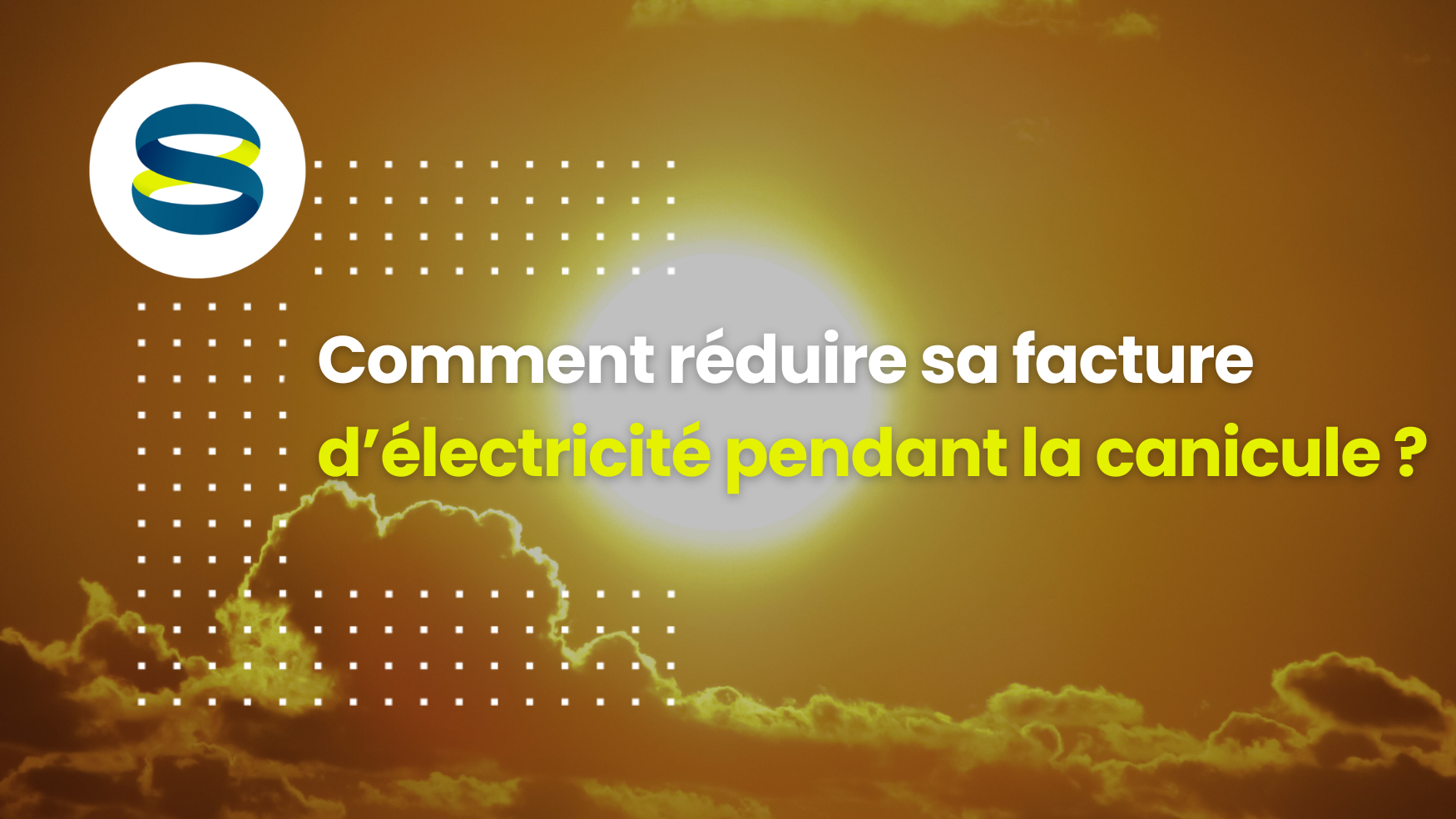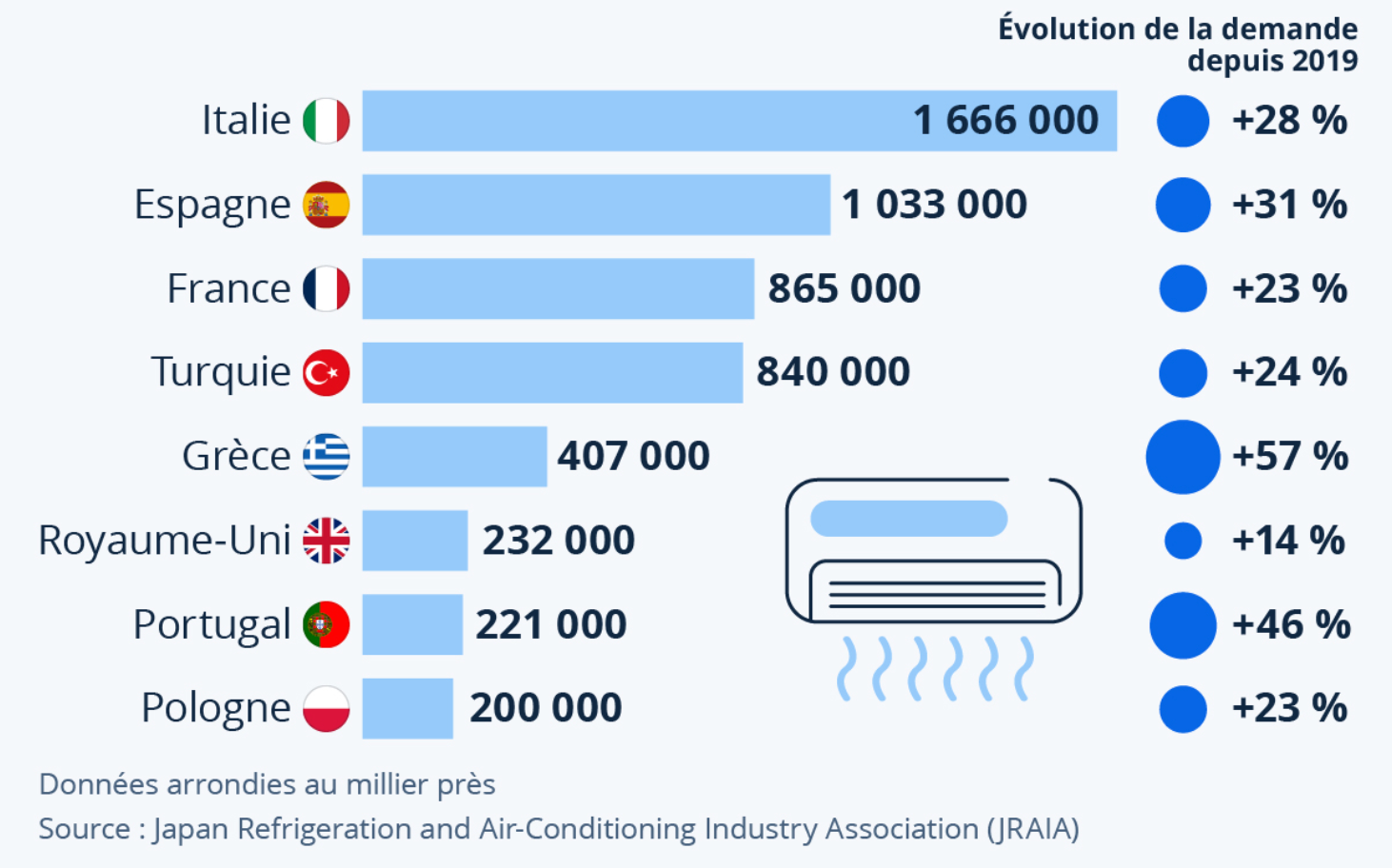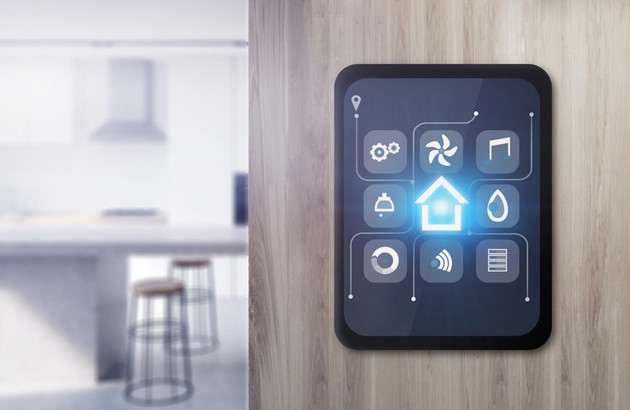

July 27, 2025
8
Min reading

Heat peak, heat wave, heatwave... so many terms that describe episodes of high temperatures.
What differentiates them? Their duration and their intensity.
Météo France defines a heatwave as a period of exceptional heat, during which temperatures exceed departmental thresholds for at least three days and three consecutive nights.
These phenomena have one thing in common: they cause a significant increase in electricity consumption, and therefore in the bill! While air conditioning is often singled out, it is not alone in the dock.
But why does the electricity bill skyrocket during a heatwave?
And above all, how can businesses stop this increase?
Light on the winning equation for not exploding the energy budget in summer.

When we talk about the rise in electricity bills during a heatwave, the first instinct is to think of air conditioning. But other factors come into play, including tensions in the electricity market or inadequate supply contracts.
During heatwaves, electricity demand experiences spectacular peaks. At issue: theintensive use of refrigeration systems to maintain a minimum of thermal comfort. Air conditioning, ventilation and refrigeration equipment are running at full speed.
This phenomenon is amplified in poorly insulated or poorly ventilated buildings and through the use oflow-performance equipment.
According to RTE, the airconditioning alone increases national consumption by 700 to 1,100 MW per additional degree.
Other uses that are more invisible are also energy-intensive in summer.
Particularly sensitive to heat, data centers intensify their cooling. Behind the shutters closed, theartificial lighting also contributes to the increase in electricity demand.
The electricity bill can increase if the contract is not adapted to the real needs of the company in summer.
During a heatwave, peak consumption can lead to overruns of the subscribed power. With penalties of several euros per hour, the bill can quickly rise in summer!
In addition, some contracts do not take into account seasonal variations, which complicates optimization in summer.
The heatwave sharply increases the demand for electricity, which often causes energy prices to soar. If the offer is struggling to keep up, tensions are emerging.
In summer, several factors can in fact: limit the capacity to generate electricity at the moment Where it is most in demand :
When the nuclear and renewable energies no longer cover demand, producers are turning to imports. The use of gas or coal-fired power plants, which are more expensive to operate, directly increases the price of electricity.
With a few simple actions and investments (quickly paid for themselves), businesses can keep their electricity bills under control during heatwaves.
Air conditioning and ventilation are the second largest source of energy expenditure for businesses, after heating. They represent on average 25% of their electricity consumption.
According to ADEME, air conditioning is also responsible for 5% of greenhouse gas emissions from buildings in France.
Limiting its use is a priority to reduce both the electricity bill and the carbon footprint of businesses.
Several simple actions help to moderate the air conditioning, while ensuring a good level of comfort:

In summer, even with empty premises, some equipment operates as if in full activity, causing waste: non-stop ventilation, standby devices, useless lighting...
Adapt the operation of the equipment to the real occupancy rate is a simple way to reduce the electricity bill. For example, this involves:
Excess consumption in the middle of summer?
The Pilott energy monitoring platform allows you to monitor your consumption station by post and to detect drifts. At the end of the day, a detailed energy management of your equipment for optimized uses in real time.
Learn more about Pilott
Controlling energy consumption also requires the involvement of each employee.
Turning off the lights, unplugging the equipment, lowering the blinds or avoiding the night before are simple but effective actions. Repeated throughout the company, they can really bring down the electricity bill.
One regular awareness-raising among teams, with internal displays and campaigns, anchors these best practices in daily life.
Adapting electricity supply contracts to the real needs of the company helps to reduce the bill.
Les Horoseasonal contracts, which distinguish between high and low season periods, offer a more advantageous rate between April and October. Thanks to the“off-peak hours” option, the company can take advantage of low-cost time slots to operate its most energy-consuming equipment.
THEoptimization of the subscribed power is also an area to be explored in order to limit overpower and financial penalties.
I want to optimize my contract
With Sirenergies, identify the contract best suited to your consumption profile and optimize your uses to take full advantage of off-season rates and off-peak hours.
Make an appointment with a SirEnergies expert
Self-consumption its own renewable electricity generates substantial savings on the electricity bill, in the order of 20% to 40%.
The financial impact is immediate in summer when the photovoltaic panels reach a peak of production.
With self-consumption, the company also protects itself against rising electricity prices during a heatwave.
In the long term, investing in photovoltaic panels is always a win, with a estimated return on investment between 5 and 10 years.
In addition to simple actions, investing in efficient equipment improves comfort while greatly reducing electricity consumption.
To replace aging air conditioning or invest in an efficient system, many solutions exist, starting with the heat pump (PARK), which has become a must.
But other innovative technologies are helping to reduce the excessive use of cooling systems, such as:
Others more sustainable solutions can be considered as the use of soil freshness (geothermal heat pump or climate sink), bio-air conditioning or evaporative air freshener (RAE), solar air conditioning, “cool roofing” or even reflective materials.
Cold storage makes it possible to produce cold during off-peak hours, when electricity costs less, and to use it later, during peak hours or in case of high heat.
For a self-consuming company, refrigeration can also be produced at the time of a peak in photovoltaic production.
Cold is stored as thermal energy (often in the form of ice or ice water) in insulated tanks or tanks.
This system smoothes consumption, limits power calls and reduces the electricity bill, while securing the cold chain.

Connected sensors and intelligent systems optimize the energy management of tertiary and industrial buildings. They not only make it possible to monitor consumption, but also to control equipment according to real needs and summer constraints.
For example, the smart thermostats regulate the indoor temperature according to the schedules, the occupancy of the premises or the weather forecasts. Associated with presence detectors, they avoid air conditioning empty rooms. For their part, the televariators adapt the lighting to the use.
In a smart building, equipment can be managed automatically. This involves a BMS (technical building management) or a GTC (centralized technical management). These systems control lighting, air conditioning, ventilation or blinds. They are based on data such as temperature, sunlight, CO₂ levels or presence in the premises.
To sustainably optimize your energy consumption, it is essential to have a clear, precise and real-time vision of its uses.
Energy management tools make it possible to monitor, analyze and manage your consumption with precision, by identifying waste and optimization levers.
Did you know that?
With Pilott, Anticipate consumption peaks and adjust your uses during off-peak hours.
A true energy dashboard, Pilott centralizes your data, facilitates decision-making and helps you control your costs.
To conclude...
A heatwave is not inevitable for your energy budget.
The implementation of simple actions and efficient equipment allows businesses to better withstand heatwaves. They also serve as sustainable optimization levers for their energy transition.
Better adjusted contracts, rational air conditioning, smart buildings, smart buildings, self-consumption or even real-time energy management: the solutions are numerous, accessible and adaptable to your budget.
Adopting a proactive approach means not only reducing your electricity bill, but also increasing energy efficiency and strengthening the resilience of your company in the face of climate hazards.
What if, instead of suffering the heat, you took back control of your energy? Sirenergies accompanies you to transform the heatwave into an opportunity.

.png)

Among the taxes include TICFE, TICGN, CTA, CJA and TURPE. They represent a significant part of the bill and vary according to consumption profiles. Understanding them well is essential to optimize costs.
.png)

These are signals sent by RTE during periods of tension on the electrical network. The Sirenergies tool informs you in real time to anticipate your uses.
.png)

Un appel d’offres permet de mettre en concurrence plusieurs fournisseurs d’électricité et de gaz afin d’obtenir des conditions contractuelles optimisées. C’est une démarche transparente qui permet de choisir l’offre la plus adaptée aux besoins budgétaires et techniques de l’organisation.
.png)

Industrial companies consume large volumes of energy for their production processes. They have to deal with the volatility of prizes, multi-site management and specific taxes. Controlling costs is essential to remain competitive.
.png)

This makes it possible to choose the right time to contract, secure your budgets and anticipate increases.
.png)

All businesses, from SMEs to large organizations, can benefit from this service. Les local authorities also find it a lever to better control their budgets.
.png)

Some businesses may obtain a partial or total exemption from the TICFE or the TICGN, depending on their activity and energy intensity. The support of an expert makes it possible to identify the eligibility criteria and to put together the file.
.png)

One invoice consists of several elements: consumption, supplier share, taxes and contributions. The analysis of each line makes it possible to identify possible errors and to check the consistency with the signed contract.


.png)

One invoice consists of several elements: consumption, supplier share, taxes and contributions. The analysis of each line makes it possible to identify possible errors and to check the consistency with the signed contract.
.png)

Use the category filters in the section: Gas, Electricity, Green Energy, Environment, budget, Energy market to target relevant topics.
.png)

Sirenergies supports SMEs in the renegotiation of contracts, the choice of the most suitable suppliers and the adjustment of the contracted power. The objective is to secure prices while avoiding unnecessary penalties.
.png)

Communities are subject to taxes such as TICFE or TICGN. Sirenergies analyzes invoices, identifies exemption possibilities and fixes possible errors to reduce the tax burden.
.png)

All businesses, from SMEs to large organizations, can benefit from this service. Les local authorities also find it a lever to better control their budgets.
.png)

It generates a budget forecast per delivery point, by comparing your actual consumption with your bills.